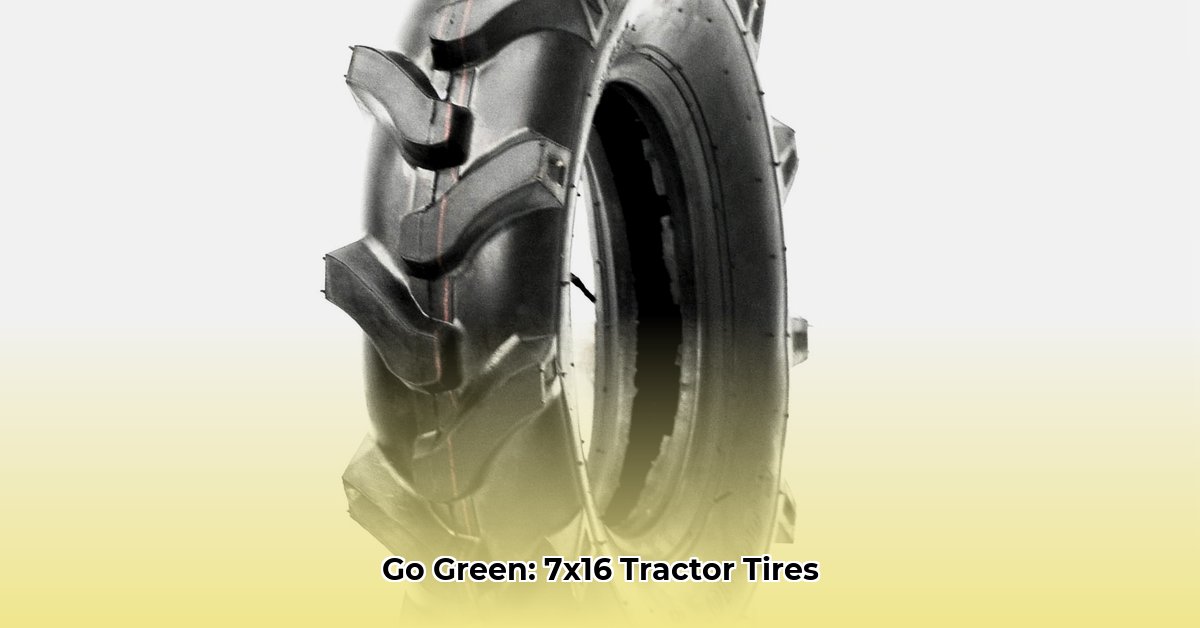
Choosing the right tractor tires significantly impacts your farm's sustainability and profitability. This guide focuses on 7x16 tractor tires, offering practical advice on optimizing their use for reduced fuel consumption, minimized soil compaction, and responsible disposal. We acknowledge upfront that comprehensive data specifically on 7x16 tires is limited; this guide will leverage general principles and best practices applicable to all tractor tires. For more information on other tire sizes, see this helpful resource on larger tractor tires.
Tire Pressure: The Foundation of Sustainable Tire Management
Proper tire inflation is paramount for both fuel efficiency and soil health. Underinflation increases fuel consumption and soil compaction, while overinflation can damage tires and harm the soil. Finding the "Goldilocks" pressure—just right—is critical.
Your owner's manual provides a starting point for recommended tire pressures for various loads and conditions. However, several factors affect ideal pressure:
- Soil type: Heavier clay soils might require different pressures than sandy soils.
- Load: Heavier loads necessitate higher pressures (within manufacturer limits).
- Temperature: Hotter temperatures increase tire pressure; colder temperatures decrease it.
Regular pressure checks—weekly, or even daily during peak seasons—are essential. A simple tire pressure gauge is an inexpensive investment with significant returns in fuel savings and soil preservation. Don't underestimate the impact of consistent monitoring. How often do you currently check your tire pressure?
Tread Patterns: Optimizing Traction and Soil Interaction
Tire tread patterns significantly impact soil compaction and traction. Deep, aggressive treads offer superior grip in muddy or loose conditions, but excessive disturbance can damage firmer soils. Conversely, less aggressive treads are gentler on the soil but may lack sufficient grip in challenging environments.
Consider your typical soil conditions. Heavier clay soils may benefit from less aggressive treads, while looser sandy soils may necessitate deeper treads for prevent slippage. Some farmers experiment with different tread patterns in various field areas, optimizing for both soil protection and traction, but this requires thorough record-keeping and observation. Further research into optimal tread patterns for diverse soil types is needed.
Low Rolling Resistance Tires: Balancing Performance and Sustainability
Low rolling resistance (LRR) tires are designed to reduce fuel consumption, offering environmental and economic benefits. However, directly comparing the fuel efficiency of different 7x16 LRR tires proves challenging due to limited publicly available data.
Look for tires explicitly marketed as LRR; however, independent verification and comparative testing are crucial. While LRR tires aim to minimize fuel consumption, the actual savings vary widely depending on several factors including operating conditions and tire design. More research is critical to provide farmers with clear guidance on LRR tire performance in real-world scenarios.
Tire Lifespan and Responsible Disposal: A Holistic Approach
Tire lifespan depends on several factors including proper inflation, load management, terrain, and maintenance. Regular inspections for cuts, wear, and embedded objects, as well as proper tire rotation, significantly extend their lifespan. This reduces waste and associated environmental impacts and ultimately lowers replacement costs.
Responsible disposal is equally crucial. Instead of discarding old tires, explore recycling options. Local tire dealers often offer recycling services, and agricultural recycling programs may also be available. Contact your local agricultural extension service or waste management authorities to examine your options; some localities may offer financial incentives for recycling agricultural tires.
A Collaborative Path to Sustainable Tire Management
Currently, comprehensive data comparing the long-term sustainability of various 7x16 tractor tires is lacking. Addressing this requires collaborative efforts:
- Farmers: Demand greater transparency from manufacturers regarding the environmental impact of their products. Share your experiences to contribute to a more comprehensive understanding of tire performance.
- Manufacturers: Provide clearer, accessible information on the environmental footprint of your tires and support independent research to validate the claims.
- Researchers: Focus research on the full lifecycle of tractor tires – from production to disposal – to offer farmers more comprehensive data.
- Government Agencies: Fund and support research into sustainable tire materials and manufacturing processes, and incentivize responsible disposal and recycling.
By working together, the agricultural sector can drive improvements, leading to a more sustainable future. Informed choices today protect our land for future generations.